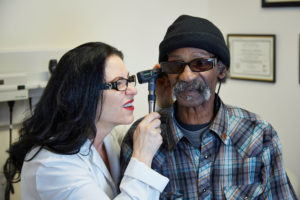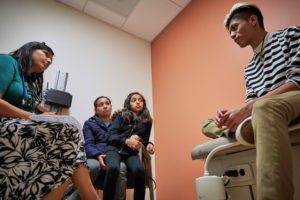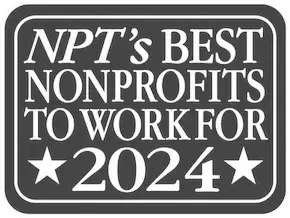Racial Inequity – as cause and effect – in the time of COVID-19
By Michelle Betton, Writer
“Structural racism has always been a pre-existing condition for communities of color.” -Race Forward
People in disinvested communities, often communities of color, understand this statement too well. It has rung true for generations. Structural racism affects more than just health; systemic discrimination has negatively impacted every aspect of life for communities of color, from accessing quality health care and education to qualifying for housing to procuring healthy food within their neighborhood.
Racial discrimination also applies to lending, whether for a home or a business, with people of color having far less access to capital. Being shut out of the lending process has meant that families of color have not had the opportunity to acquire the generational wealth that homeownership and business ownership afford.
As COVID-19 has spread across the country, it has become just the latest spotlight showing how strongly structural racism continues to oppress communities of color. From economics to health to everyday existence, this disease is showing that much work remains to be done to bring about equity and shared prosperity.
Racism Exacerbates COVID-19 Outcomes for Communities of Color
In our blog, we’ve explored a variety of the stark impacts historical racism and disinvestment have had on communities of color and communities with low incomes. This has become much clearer as COVID-19 has wreaked havoc on our health, economic, and social systems.
“The increased vulnerability of people of color in this country does not ‘just so happen,” Dr. Camara Phyllis Jones says. “Indeed, the over-representation of people of color in poverty and the over-representation of ‘White’ people in wealth does not ‘just so happen.”
Policies like redlining and practices like poor education for students in communities with low incomes have kept many in communities of color from attaining lives beyond poverty. Discriminatory practices have resulted in many people of color having limited or no savings; limited or no access to quality health care, insurance, or sick leave; and few other material resources. On a normal day, this keeps peoples’ well being in jeopardy; during a pandemic, it can completely pull the rug out from under a family.
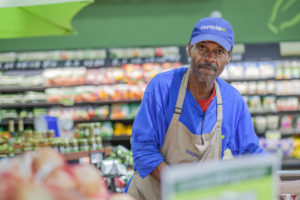
The nature of work for many people of color places them at greater risk for contracting novel coronavirus.
The concept of self-quarantining can be difficult for communities of color to maintain. People of color tend to live in urban areas like cities, dense neighborhoods, or public housing; people of color also experience housing insecurity or homelessness. Additionally, many people of color work in “forward-facing” industries, such as health care, transportation, and grocery stores or food service, which increases their likelihood of coming into contact with the virus.
Specific examples of how disproportionately the Black community is being impacted by COVID-19 are shocking. In Michigan, African Americans only make up 14 percent of the state’s population, but comprise 32 percent of cases and roughly 40 percent of deaths. In Washington, D.C., African Americans make up about 46 percent of the city’s population, but account for 77 percent of the District’s COVID-19-related deaths.
In Los Angeles, COVID-19 deaths are highest among Asian American/Pacific Islanders, Black Americans, and Latinx. In Santa Clara County, CA, the Latinx community accounts for most COVID-19 cases and deaths — 33 percent of reported infections and 34 percent of fatalities – despite making up only 27 percent of the population. Black Americans make up only 2 percent of the counties population, but make up 2 percent of the known cases and 6 percent of deaths.
In Chicago, Black residents comprise 29 percent of residents, but 84 percent of COVID-19 deaths. In the face of these incredible numbers, the city’s mayor, Lori Lightfoot, labeled this “a call-to-action moment for all of us. When we talk about equity and inclusion, they’re not just nice notions. They’re an imperative that we must embrace as a city. It’s unacceptable. No one should think that this is OK.”
COVID-19 is Exposing Deep Cracks in Access to Health Care…
Naturally, in this pandemic, the clearest amplification of disparities relates to health and health care.
Access to healthy food can be sparse in communities with low incomes and particularly in communities of color. Lack of access to healthy, fresh foods has been a driver for chronic diseases in communities of color like obesity, and the same is true for COVID-19.
Systemic racism, specifically redlining, has led to environmental racism, in which communities of color are forced to live in areas with power plants, bus depots, and other environmentally hazardous locations with polluted air and water, or those polluters are built within communities of color because the residents have little power to oppose them.
As a result, Black Americans experience a disproportionate number of chronic illnesses such as asthma, high blood pressure, and diabetes — all of which are underlying conditions that exacerbate the effects of COVID-19.
It is important to note that people talk about the underlying illnesses that predispose people of color to negative health outcomes. However, there is nothing inherent within communities of color that leads to these outcomes, other than the racism that people experience daily.
People of color are also more likely to be uninsured or underinsured and live in communities with inadequate health care facilities. In 2018, more than 11 percent of Black Americans, 19 percent of Latinx, and 22 percent of Native Americans remained uninsured, compared to seven percent of Asian/Native Hawaiian and Pacific Islanders and eight percent of White Americans.
Anthony Fauci, director of the National Institute of Allergy and Infectious Diseases who is one of the leaders of the White House Coronavirus Task Force, stated that COVID-19 is “shining a bright light on how unacceptable” those disparities are.
Two communities that have seemed largely invisible during this crisis have been migrants in detainment camps and residents in our nation’s prisons. Experts urged the release of migrant detainees for fear of the health implications for such a fast-spreading illness. Considerable news documentation has shown that migrants in many detention camps already experience poor health conditions, from overcrowding to insufficient medical care. Those conditions are the perfect spreading ground for an illness; and with the death of the first detainee from the disease, the situation could become dire. The same is true for men and women in prisons; living in close quarters and often poor health care makes them especially vulnerable. So does the fact that many in prisons are people of color, who have more pre-existing conditions that create vulnerabilities to COVID-19 than their White counterparts.
Investing in critical social services that benefit everyone provides a safeguard for times like these. Today, without that safety net, the health of many Americans is suffering.
…And the Same Is True for Economic Outcomes
Economic disparity was already a prevailing story across the country when COVID-19 hit. While White families nationwide are also suffering from the widening gap between people with low incomes and the wealthy, the weight of the economic divide falls disproportionately on communities of color. Black, Latinx, and Native American families tend to have little-to-no savings or liquid assets to weather financial hardships, and with low homeownership rates, they have little ability to build generational wealth that is tied to owning a home.
These barriers set a high wall for communities of color to have to climb in order to achieve prosperity. In Chicago, one in three families do not have sufficient savings to live for three months at the federal poverty level given a sudden interruption in income, which is surely the case now for families across that city and in many other places. In New Orleans, another city hard-hit by the pandemic, 61.3 percent of Black households are liquid-asset poor, while that is true for only 25.3 percent of White households. For the New York-New Jersey-Pennsylvania metro area, liquid-asset poverty is 53.2 percent for families of color and 22.3 percent for White families. In each of these areas, COVID-19 infection rates are much higher among individuals of color, which means that their families have far less with which to care for them and their family’s wellbeing.
Unemployment in this time is reaching record highs. With the month of April alone, more than 21 million jobs were lost. More than 30 million people filed for unemployment between Mid-March and early April. Unemployment rose to 16 percent from March’s level of 4.4 percent. Individuals and families with few assets will be hurt the most by this. With no salary coming in, people of color could also lose their housing. Larger numbers of Black and Latinx renter households stated that they had difficulty in paying their monthly rent in 2019 than their White counterparts. That reality will now have compounded for families of color.
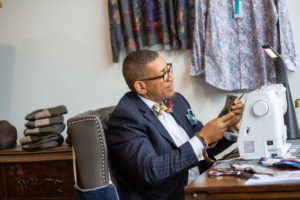
Black and brown-owned businesses struggle to access financing during normal times; COVID-19 has and will continue to compound their ability to support themselves and their communities, which could lead many to close.
Small, local businesses are suffering equally. Businesses owned by people of color are often very well integrated in their communities, supporting direct community needs. More than $103 billion: that is the annual revenue that Black-owned companies with paid employees generate; the largest portion (about $17 billion) of that revenue is earned in the health care and social assistance sector. That injects their local economies with vital financial resources.
Many small businesses, regardless of race, have been left out of receiving loans through the Payroll Protection Program, while larger companies (some quite large) with more established banking relationships jumped ahead. Businesses owned by people of color saw a particular lack of support, especially Black-owned businesses. Out of the original $349 billion stimulus package, the Minority Business Development Agency received only $10 million, nowhere near enough to support POC-owned businesses nationwide. Additionally, there was no set-aside for Community Development Financial Institutions and other nonprofit lenders that focus specifically on bridging the financial gaps that communities of color face. These organizations, like Capital Impact Partners, are poised to support communities’ economic wellbeing, during this time and beyond.
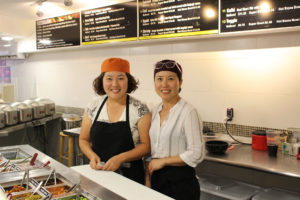
Financing is key to ensuring the businesses owned by people of color are not left without the resources to survive.
At a time when the country’s economy will struggle to return to previous levels, every business is needed to recharge our economic batteries and get people back to work. With the sheer volume of business done by POC-owned businesses, the nation needs all businesses to be supported, especially communities of color which tend to have fewer retail options.
Education Is Suffering During COVID-19
Education outcomes between communities of color and White communities have been disparate for generations, and COVID-19 is likely to widen that gap.
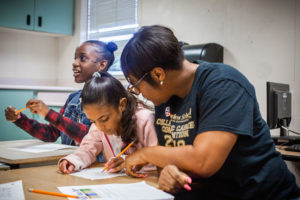
With the coming school year looking like it will be digital for many areas, students of color who have less access to computer or internet access will be at a greater disadvantage.
Communities of color often have less access to computers at home or internet access to support the online learning that many school districts are now implementing. New York City’s public school system – the country’s largest – serves 300,000 students who do not have electronic devices at home. This digital divide called the “homework gap” will make it harder for children whose circumstances already create a disadvantage to achieve their educational goals.
The same is true for some college students. On campus, students can feel equal; however when students across the country were sent home because of COVID-19, the ability of students to continue their education at the same level varied. Internet access, family obligations, and housing have placed education up in the air for many.
As many jurisdictions move to e-learning, some are standing in solidarity with students, underscoring the increased inequity that the homework gap creates. Philadelphia decided not to offer e-learning for its students because the majority of its public school students live in families with low incomes, the idea being that online education should not disproportionately benefit a minority of students. Education is one of the surest paths to transforming poverty into shared prosperity; a crisis should not take away a chance at a brighter future.
Racism Is Rearing Its Violent Head
Outside of the impacts of discrimination on the health and wellbeing of people of color, COVID-19 has shown the inherent racism against communities of color, in this case Asian Americans, when it comes to illness. Almost as soon as this pandemic began, Asian Americans and Pacific Islanders began being scapegoated as the “origin” of the illness.
That scapegoating showed up in the form of confronting and accusing Asian Americans of spreading the disease, despite the fact that the illness arrived in the United States via travelers of various races and ethnic origins, including White individuals. Asian Americans and Pacific Islanders across the United States reported more than 1,500 incidents of racism and discrimination related to COVID-19 in April alone. Unfortunately, the Asian community has experienced prejudice fueled by illness before.
On another painful level, wearing a face mask in public can be injurious and potential dangerous for people of color. The narrative of Black Americans and Latinx as criminals without honoring their humanity – the recent killing of Ahmaud Arbery, for example – has made it unsafe for people of color to just be in public. That basic premise led to the hashtag #WhileBlack, showcasing the suspicion and over-policing that Black Americans experience while engaging in activities in their everyday lives. In the context of COVID-19, it forces people of color to choose the greater evil – be exposed to a deadly virus or risk perceived malintent and potential violence from wearing a mask #WhileBlack.
It is a shame that we, as a society, have to “re-learn” the impacts of racism experienced by communities of color with each emergency. Collective disregard and ignorance is, in part, what allows this inequity to continue.
If everyone in the United States experienced the weight that racism places on the shoulders of people of color…actually, COVID-19 offers the perfect opportunity to internalize that experience, as described in this quote from a recent article in The Washington Post:
“You know how you’re scared to go outside right now because you don’t know if the virus might be transmitted to you? How you’re scared you might lose your job right now and you don’t know how you’re going to take care of your kids? That’s how racism feels every day. … You cannot only see inequality in things like health care, but feel this emotional experience of fearing something that’s out there but you can’t really control it. That’s how racism works.
“This type of stress that whites are feeling now, about being sick, will I be able to get health care, will I have a job, economic anxiety, all of those things people of color feel all the time because of racism. Racism is like this virus: It’s floating around. It may hit me today; it may cause me to lose my job; it may mean that I have to get health care; it may mean I can’t get health. If we could just capture it and say, ‘Hey this happens all the time with people of color because of racism,’ then I think we can open the door to a different conversation about the racial impact of covid-19.”
If society faced these truths head-on, we could begin to work toward lasting systems change that would uplift rather than hold communities of color down. Mission-driven organizations have been facing these realities for years. Community Development Financial Institutions like Capital Impact Partners were born out of the civil rights movement, when communities of color fought for basic dignities like equal education, the right to vote, and the right to equal access to health care and transportation.
Our work since then has been to build the power of disinvested communities through targeted flexible financing and programmatic support so that they can become places of opportunity, where everyone has their needs met and can achieve their goals. At Capital Impact, we have centered equity within our organization, creating an equity statement that lays out the world we want to see and how we will work to achieve it.
This moment, when COVID-19 has stopped us all in our tracks, is a level-setting moment, an opportunity to state how we want systems to work for people and set into motion the policies, collective behaviors, and mutual care that will enable transformation.
We stand ready to work with anyone to create places of opportunity for future generations. If we do not take this chance now, we should not be surprised to “re-learn” that these inequities have not changed whenever the next crisis raises these issues again.
